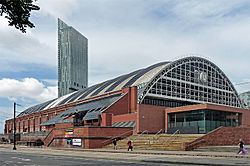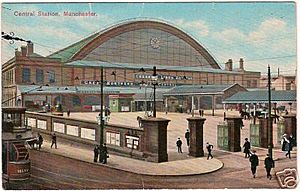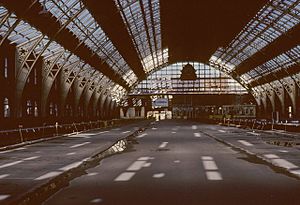Manchester Central Convention Complex facts for kids
Quick facts for kids Manchester Central Convention Complex |
|
|---|---|
 |
|
| Former names | Greater Manchester Exhibition Centre (1986–2006) |
| General information | |
| Status | Grade II |
| Architectural style | 19th Century railway terminus, cast iron and red brick |
| Location | Manchester City Centre |
| Address | Windmill Street Petersfield Manchester Greater Manchester M2 3GX England |
| Coordinates | 53°28′34″N 2°14′51″W / 53.476132°N 2.247369°W |
| Construction started | 1982 |
| Completed | 1986 |
| Opened | 21 March 1986 |
| Renovated | 2008–09 |
| Cost | £20 million |
| Renovation cost | £30 million |
| Owner | Manchester City Council |
| Height | 90 feet (27 m) |
| Dimensions | |
| Other dimensions | Arch span: 210 feet (64 m) Hall length: 550 feet (168 m) long |
| Technical details | |
| Structural system | 2-storey brick building with single-span segmental iron and glass arched roof |
| Design and construction | |
| Architecture firm | EGS Design |
| Main contractor | Alfred McAlpine |
| Renovating team | |
| Renovating firm | Stephenson Bell |
| Manchester Central Convention Complex | |
|---|---|
| Operator | Manchester Central Convention Complex Ltd. |
| Banquet/ballroom | 1,200 (Exchange Hall) |
|
Theatre seating
|
10,900 (Central Hall) 804 (Exchange Auditorium) |
| Enclosed space | |
| • Total space | 17,776.71 m2 (191,346.9 sq ft) |
| • Exhibit hall floor | 11,834.56 m2 (127,386.1 sq ft) |
| • Breakout/meeting | 2,820.15 m2 (30,355.8 sq ft) |
Manchester Central Convention Complex (commonly known as Manchester Central or GMEX) is an exhibition and conference centre converted from the former Manchester Central railway station in Manchester, England. The building has a distinctive arched roof with a 64-metre span - the second-largest railway station roof span in the United Kingdom, and was granted Grade II* listed building status in 1963.
After 89 years as a railway terminus, it closed to passengers in May 1969. It was renovated as an exhibition centre formerly known as the G-Mex Centre in 1982 and was Manchester's primary music concert venue until the construction of the Manchester Arena. After renovation the venue reverted to its former name Manchester Central in 2007.
The Complex is to become a temporary field hospital for non-critical coronavirus patients, or Fangcang Hospital, part of a network of temporary NHS Nightingale Hospitals.
Contents
History
Manchester Central railway station
The complex was originally Manchester Central railway station, one of the city's main railway terminals.
Designed by Sir John Fowler, the station was opened in July 1880 by the Cheshire Lines Committee. The station served as the terminus for Midland Railway express trains to London St Pancras. The station's large arched roof – a huge wrought-iron single-span arched roof, spanning 210 feet (64 m), 550 feet (168 m) long and 90 feet (27 m) high – was a noted piece of railway engineering and is the widest unsupported iron arch in Britain after the Barlow train shed at London St Pancras.
At its height, in the 1930s, more than 400 trains passed through the station every day. The station operated for 89 years, before closing in May 1969.
G-Mex Centre
In 1978, the structure was acquired by the Greater Manchester County Council to redevelop as a concert venue. In 1982 construction work undertaken by Alfred McAlpine It was the centrepiece of the regeneration plan for the area and wider Castlefield district. The hall covered 10,000 square metres and could be partitioned into various sized units for different exhibitions. Initial construction work concentrated on repairing the derelict structure and re-pointing brickwork which took 18 months. The Greater Manchester Exhibition Centre or G-Mex Centre was opened by Queen Elizabeth II in 1986 after four years of renovation.
In 2001, the Manchester International Convention Centre (MICC) was added, comprising an 804-seat auditorium and breakout rooms and the Great Northern Hall. In 2005, the company running the complex was bought by Manchester City Council. G-Mex was Manchester's primary concert venue from 1986 to 1995. Its position as a concert venue diminished after the opening of the Manchester (then NYNEX) Arena in 1995.
Manchester Central
In January 2007 it was renamed Manchester Central, evoking the memory of the former station and converted into an exhibition and conference centre. The building was renovated at a cost of £30 million in 2008 by Manchester-based architects, Stephenson Bell. The first phase to create a foyer took from February to November 2008.
The second phase, completed towards the end of 2009, included an extended foyer to the Grade ll listed Central Hall. The old smoked-glass structure was demolished and replaced by a flat-roofed, clear-glazed structure exposing more of the original architecture. The final phase, completed in September 2010, focused on the rear of the building. New event spaces were built and rooms refurbished to increase the venue's range and size of meeting and banqueting spaces.
Events
During its days as the G-MEX Centre, the venue was used for hosting rock concerts. Not long after its official opening, Factory Records used the venue for their Festival of the Tenth Summer in July 1986 to celebrate the 10th anniversary of Punk in the city, and included appearances by The Smiths, and Factory Records stalwarts New Order. James appeared in 1990, U2 in June 1992, Metallica in November 1992 on their The Black Album tour and The Cure in November 1992. G-Mex had a seating capacity of 9,500 for end stage concerts and 12,500 for standing events and stopped hosting concerts in 1997, with the last gig by Oasis in December. G-Mex was also the 2002 Commonwealth Games venue for gymnastics, weightlifting, judo and wrestling.
After a nine-year break, it was again used for concerts by Snow Patrol in December 2006 with Morrissey, The Verve. Marilyn Manson, Franz Ferdinand, Manic Street Preachers, Arctic Monkeys, Bloc Party and Hard-Fi holding concerts in 2007. Status Quo have performed there multiple times. The venue hosted concerts by Placebo in December 2009, Arcade Fire, Biffy Clyro, Thirty Seconds to Mars, The Taste of Chaos Tour 2010, deadmau5, Pendulum in December 2010 and The Eighth Plague Tour. In 2011, it hosted The Girls' Day Out Show.
In 2009 and 2010, it played host to the Manchester audition stages of the ITV programme The X Factor and in December 2012, the hosted the finals of series 9 of The X Factor.
In September 2006, the Labour Party moved from traditional seaside venues to hold its annual party conference at the complex, returning to the venue in 2008, 2010, 2012 and 2014. It has also hosted conferences for the Confederation of British Industry, ECOFIN, the Liberal Democrats and the Conservative Party. Conservatives in 2006, 2009, 2011, 2013, 2015, 2017 and 2019.
The venue is also the filming location of Ninja Warrior UK.
Transport
Located in the heart of the city, Manchester Central is served by two Metrolink tram stops - Deansgate-Castlefield tram stop and St Peter's Square tram stop both of which are under a five-minute walk from the venue. National Rail local train services serve Deansgate railway station whilst Manchester Piccadilly is a twenty-minute walk away.
Emergency hospital
On 27 March 2020, the UK government announced that the building would be converted into an emergency hospital, part of a network of NHS Nightingale Hospitals similar to the NHS Nightingale Hospital London already under construction, intended to deal with the COVID-19 pandemic and with 1,000 beds. It opened on 17 April 2020.



